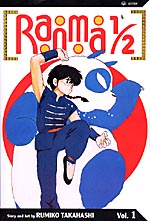 By Rumiko Takahashi
By Rumiko Takahashi
312 pages, black and white
Published by Viz
If you had to pick Japanese comic book superstar Rumiko Takahashi’s greatest success, I think most would agree that it’s Ranma 1/2. With 34 collected volumes of comics, to say nothing of the 7-season/143-episode animated series, and multiple theatrical and direct-to-video stories, there’s a whole lot of Ranma 1/2 material out there. It’s best to start at the beginning, though, and with Viz’s new edition of Ranma 1/2 having just hit stores, there’s never been a better time to take a look at what started it all.
Ranma Saotome was betrothed as a child to one of martial artist Soun Tendo’s three daughters, to help carry on the Tendo martial arts school. Now, Akane Tendo is about to meet her future husband for the very first time, but there are just a couple of problems. First, Akane doesn’t want to get married. Second, there’s already a battle raging every morning at school among all the boys who do want Akane’s hand. And third, when Ranma and his father show up at the Tendo dojo, Ranma is a woman… Well, sort of. You see, there’s a story in that, involving a series of cursed springs…
The first time someone tried to explain Ranma 1/2 to me, my eyebrows immediately shot up. “When Ranma is splashed by cold water,” my friend gamely attempted, “he becomes a woman, and only hot water turns Ranma back to normal.” It took him several additional minutes to explain that no, no, Ranma 1/2 is a romantic comedy and not some particularly odd porn book. Once I read Ranma 1/2 for myself, I was able to start really understanding the charm. Takahashi’s able in these early stories to weave martial arts, romantic tension, cheap laughs, and a screwball concept all into a single narrative without breaking a sweat. The first couple of volumes of Ranma 1/2 are really special with all of the strong characterization and unexpected twists that she’s able to infuse into the book; we get to see a lot not only of Ranma and Akane’s relationship, but a really well-depicted supporting cast. Later volumes have the more “normal” characters fall into the background (like Akane’s sisters Kasumi and Nabiki, or Akane’s original love Doctor Tofu) in favor of stranger and crazier creations, but I think Takahashi’s able to make these characters just as intriguing and full of character hooks to keep readers interested. It’s a much more human approach, which fits well with these early moments of Ranma and Akane starting to connect, even if they can’t consciously admit to it. Having Ranma tell Akane during a duel that she’s pretty when she smiles, only to tag her as she’s pauses in surprise is a perfect defining moment of their relationship.
In a word, Takahashi’s art is enchanting. It continually surprises me on how much emotion and humor she’s able to pack into such a small space. Just a single panel can have me laughing hysterically, like when Genma in panda form holds up a despairing “Arrrgh! Pandas can’t talk!” sign while trying to helpfully answer the telephone… or just as easily tug on my heartstrings when Akane tentatively looks at her own smile in a mirror after Ranma complements her on it. Takahashi’s storytelling in these early volumes is really tight; it could serve as a primer for how to tell stories effectively and without filler. Every panel plays an important part, and it really surprised me upon rereading Volume 1 on just how much story she packs into these 300 pages.
Looking at Ranma 1/2 Vol. 1, it reminded me once more on just why Takahashi is one of the most successful comic creators in Japan… and quite possibly the entire world. With all of the early volumes now being reprinted in the new attractive Action Edition format, it’s even more affordable to see just what all the buzz is about.
